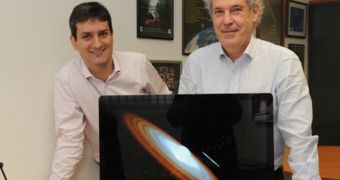A collaboration of Spanish astronomers from several universities and research institutes was recently able to provide compelling evidences for the discovery of the first binary system consisting of a spinning star, or Be star, accompanied by a black hole.
Like all other stars, Be-class stars spin around their axis. Unlike other stars, these objects do so at nearly top velocity, meaning that if they were to spin any faster, they would disintegrate into the surrounding space. Due to the high centrifugal forces generated by the fast spin, these celestial orbs are flattened at the pole, and bulge outwards from their equators.
For many years, astronomers such as Jorge Casares from the Instituto de Astrofísica de Canarias (IAC) and La Laguna University (ULL) in Spain, have proposed the possibility that binary systems exist where Be stars are accompanied by black holes. The new study was able to accurately identify such a system.
For the investigation, scientists used the Liverpool and Mercator telescopes, which are installed at the Observatorio del Roque de los Muchachos, on the Canary Islands, in Spain. Details of the study appear in a paper published in the January 16 issue of the top scientific journal Nature.
Casares, who first proposed that black holes can accompany spinning stars nearly 22 years ago, was the lead author of the new paper, and the leader of the research group. He is a world-renowned expert on stellar-mass black holes, which are dark behemoths weighing only several times the mass of the Sun.
In the case of the newly-found binary system, centered on the Be star MWC 656, the companion black hole is estimated to weight between 3.8 and 6.9 solar masses. Its exact mass is difficult to pinpoint, even with out most advanced telescopes, experts comment.
The binary system lies in the constellation Lacerta (the Lizard), some 8,500 light-years from Earth. Its visible member, MWC 656, features a surface speed estimated at nearly 1 million kilometers (621,371 miles) per hour.
“We started studying this star back in 2010, when space telescopes detected transient gamma-ray emission coming from its direction. No more gamma-ray emission has subsequently been detected, but we found that the star was part of a binary system,” explains Marc Ribó, an astronomer with the Institute for Sciences of the Cosmos at the University of Barcelona (ICCUB/IEEC-UB).
By analyzing the spectrum of MWC 656, scientists were able to learn a variety of new things about its companion, such as its mass. This in turn helped them establish that the companion object was not a neutron star.
“An object like that, invisible to telescopes and with such large mass, can only be a black hole, because no neutron star with more than three solar masses can exist,” concludes Institute of Space Sciences (IEEC-CSIC) researcher Ignasi Ribas.

 14 DAY TRIAL //
14 DAY TRIAL //